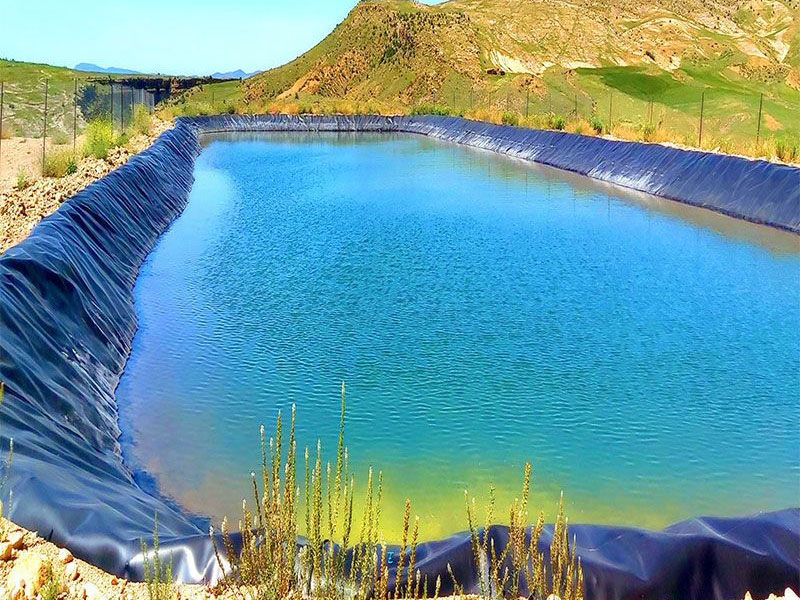
Geomembrane has many important applications in agricultural irrigation, mainly in channel anti-seepage, reservoir anti-seepage and drip irrigation system assistance.
Channel anti-seepage application principle
In agricultural irrigation channels, traditional soil channels have strong water permeability, and a large amount of irrigation water will leak into the ground during transportation, resulting in serious waste of water resources. Geomembrane has good anti-seepage performance. Laying it at the bottom and slope of the channel can effectively prevent water from infiltrating and improve the utilization rate of water resources.
Specific application method
Base treatment: Before laying the geomembrane, the channel base needs to be leveled and compacted, and sharp stones, branches and other debris need to be removed to avoid puncturing the geomembrane.
Geomembrane laying: Cut the geomembrane according to the shape and size of the channel, and then lay it from one end of the channel to ensure that the geomembrane is flat and wrinkle-free. The adjacent two geomembranes are connected by hot melt welding or gluing to form a continuous anti-seepage layer.
Protective layer construction: In order to prevent the geomembrane from being damaged by the external environment, such as ultraviolet radiation, mechanical damage, etc., it is necessary to lay a protective layer on the geomembrane, such as a gravel layer, concrete slab, etc.
Application effect
By using geomembranes for channel anti-seepage, the leakage loss in the channel water delivery process can be significantly reduced, and the utilization coefficient of irrigation water can be improved. For example, in the reconstruction of irrigation channels in some arid areas, after the use of geomembranes for anti-seepage, the water delivery efficiency of the channel has increased by 30% - 50%, greatly saving water resources.
Reservoir anti-seepage application principle
Agricultural reservoirs are used to store irrigation water to meet the water demand of farmland in different seasons and climatic conditions. The anti-seepage performance of geomembranes can prevent water in the reservoir from leaking into the ground, ensuring the water storage capacity and water supply capacity of the reservoir.
Specific application method
Pool bottom treatment: Level and compact the bottom of the reservoir, remove debris and sharp objects, and lay a layer of fine sand or geotextile as a cushion to protect the geomembrane.
Geomembrane laying: Lay the geomembrane according to the shape and size of the reservoir, extending from the bottom of the pool to the pool wall to ensure that the geomembrane fits tightly with the pool wall. At the corners of the pool wall, the geomembrane needs to be specially treated, such as folding and welding, to prevent leakage points.
Fixing and sealing: Use layering strips, anchoring trenches, etc. to fix the geomembrane to the pool wall and bottom, and seal the joints and edges of the geomembrane to ensure the anti-seepage effect of the reservoir.
Application effect
The application of geomembranes can effectively improve the water storage efficiency of the reservoir and reduce water evaporation and leakage losses. In some mountainous or arid areas, reservoirs with geomembrane anti-seepage can provide a stable irrigation water source for farmland and improve the reliability of agricultural production.
Drip irrigation system assistance
Application principle
Drip irrigation is an efficient water-saving irrigation method that slowly and evenly drips water into the roots of crops through drippers. Geomembrane can be used in the underground part of the drip irrigation system, such as laying under the drip irrigation pipe to prevent water from leaking downward and ensure that water can be accurately delivered to the roots of crops.
Specific application method
Laying geomembrane: Before installing the drip irrigation system, lay a layer of geomembrane in the planting area and arrange the drip irrigation pipe above the geomembrane. The geomembrane can play a role in water isolation, preventing water from leaking downward into the deep soil layer, so that water can be better concentrated in the root area of the crop.
Cooperate with the drip irrigation system: The combination of geomembrane and drip irrigation system can be used for precise irrigation according to the water demand of crops and improve the utilization efficiency of water resources. At the same time, geomembrane can also reduce the growth of weeds and reduce the cost of weed control.
Application effect
The application of geomembrane in the drip irrigation system can further improve the water-saving effect of drip irrigation, enable crops to better absorb water and nutrients, and promote crop growth. For example, in some economic crop planting areas, the use of geomembrane-assisted drip irrigation system not only saves water resources, but also improves the yield and quality of crops.

